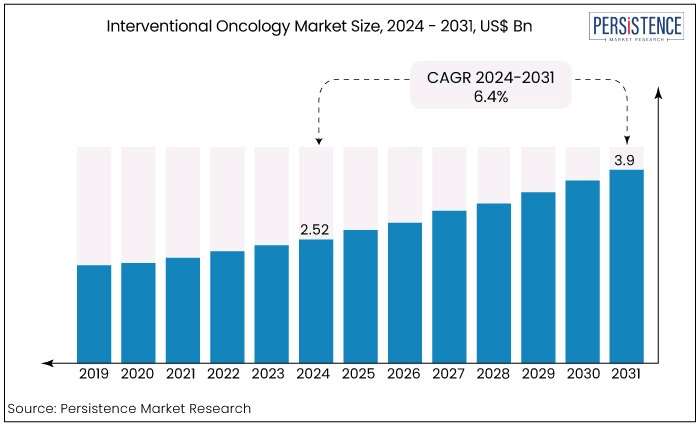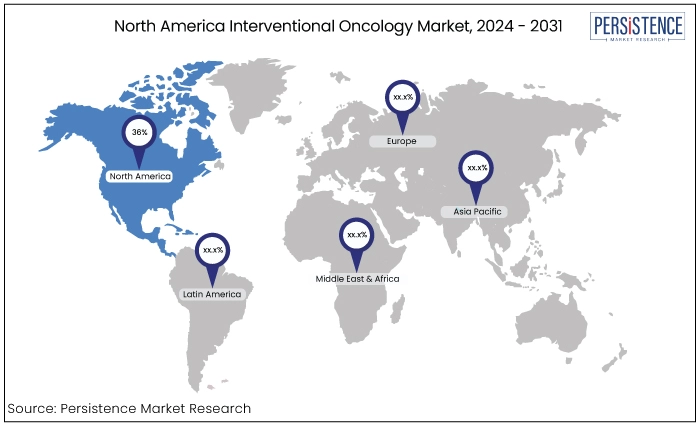Interventional Oncology Market
Industry: Healthcare
Published Date: August-2024
Format: PPT*, PDF, EXCEL
Delivery Timelines: Contact Sales
Number of Pages: 196
Report ID: PMRREP34749
The interventional oncology market is estimated to increase from US$2.1 Bn in 2024 to US$3.5 Bn by 2031. The market is projected to record a CAGR of 8.1% during the forecast period from 2024 to 2031.

Key Highlights of the Market
|
Market Attributes |
Key Insights |
|
Market Size (2024E) |
US$ 2.1 Bn |
|
Projected Market Value (2031F) |
US$ 3.5 Bn |
|
Global Market Growth Rate (CAGR 2024 to 2031) |
8.1% |
|
Historical Market Growth Rate (CAGR 2019 to 2023) |
7.3% |
|
Region |
Projected CAGR through 2031 |
|
North America |
8.3% |
North America is leading the interventional oncology market due to its advanced healthcare infrastructure, high prevalence of cancer, and strong emphasis on medical innovation. This regional market is estimated to record a CAGR of 8.3% through 2031.
The region boasts a well-established network of leading hospitals and specialty centres equipped with state-of-the-art technologies for interventional procedures. Substantial investments in research and development coupled with significant funding from both public and private sectors drive innovation and the adoption of new treatment modalities.
The presence of a large number of skilled professionals and a robust regulatory framework also supports the growth of the market. Increasing awareness of cancer treatments and a focus on improving patient outcomes further solidify North America's position as a dominant player in the market.

Asia Pacific is estimated to exhibit the high growth rate during the forecast period. The rapid growth of the interventional oncology market in Asia Pacific is driven by several key factors. The increasing prevalence of cancer in the region, coupled with a rising aging population, has heightened the demand for advanced cancer treatment options.
Significant improvements in healthcare infrastructure and growing investments in medical technologies are enhancing the availability and quality of interventional oncology procedures.
Government initiatives aimed at improving cancer care and expanding access to cutting-edge treatments are also contributing to market expansion.
The rising awareness of cancer treatment options and the growing adoption of minimally invasive procedures among patients and healthcare providers are accelerating the market's growth in Asia Pacific.
|
Category |
Projected CAGR through 2031 |
|
Product Type - Ablation Devices |
8.7% |
Based on the product type, the interventional oncology market is further segmented into ablation therapy devices, ablation devices, and embolization devices. Among these, ablation devices segment dominates the market.
Ablation devices are leading the product type category in the market due to their significant role in providing effective and minimally invasive treatment options for cancer. The ablation devices, including radiofrequency ablation (RFA), microwave ablation, and cryoablation have revolutionized the approach to tumour management by offering precise targeting of cancerous tissues.
The ability of device to treat a wide range of tumours in various organs such as the liver and lungs contributes to their dominant position in the market. The increasing preference for minimally invasive procedures combined with advancements in ablation technology reinforces the leading role of ablation devices in enhancing treatment efficacy.
|
Market Segment by Cancer Type |
Projected CAGR through 2031 |
|
Cancer Type - Lung Cancer |
8.7% |
Based on cancer type, the interventional oncology market is further sub segmented into lung cancer, liver cancer, and kidney cancer. Among these, the lung cancer segment dominates the market. Lung cancer remains one of the most common and challenging cancers worldwide driving substantial demand for effective and innovative treatment options.
Interventional oncology techniques such as ablation and embolization are increasingly employed to manage lung tumours, offering minimally invasive alternatives to traditional surgical approaches. The high incidence of lung cancer and the need for precise, targeted treatments contribute to the prominent focus on this cancer type within the market.
As advancements continue and the need for improved patient outcomes grows, lung cancer remains a central area of development and investment in the interventional oncology field.
The interventional oncology market is experiencing robust growth driven by the escalating prevalence of cancer and the increasing preference for minimally invasive treatments. The shift from traditional surgical methods to advanced interventional techniques such as radiofrequency ablation, cryoablation, and transarterial chemoembolization highlights a trend toward targeted therapies.
The integration of cutting-edge imaging technologies including MRI and CT scans further enhances the accuracy of these procedures by improving tumour targeting. Trend analysis indicates a growing emphasis on personalized medicine within the market aimed at tailoring treatments to individual patient needs for better outcomes.
Continuous innovations in device technology and heightened investments in research are driving market growth. The focus on cost-effective and patient-centred care is also leading to the development of new techniques and devices.
The market is set for significant expansion, addressing the evolving challenges in cancer treatment as technological advancements continue and the demand for effective, minimally invasive therapies increases.
The market has experienced significant growth mainly due to technological advancements and a growing preference for minimally invasive procedures during the period from 2019 to 2023.
Innovations such as radiofrequency ablation, cryoablation, and transarterial chemoembolization have revolutionized cancer treatment providing patients with effective alternatives to conventional surgery in recent years.
The expansion of the market has been driven by the development of advanced imaging techniques, which have improved the precision and effectiveness of these procedures. Consequently, interventional oncology has become a crucial aspect of modern cancer treatment addressing the need for targeted and less invasive therapies.
The interventional oncology market is poised for continued growth driven by several emerging trends. The shift toward personalized medicine is expected to foster further advancements with treatments becoming more tailored to individual patient needs and specific tumour profiles.
Technological progress including advancements in imaging systems and the introduction of innovative interventional devices is anticipated to enhance treatment effectiveness and patient safety.
The rising global cancer incidence and the increasing demand for cost-effective healthcare solutions are likely to propel market expansion. As these trends evolve, the interventional oncology market is positioned to play a crucial role in advancing cancer treatment providing new solutions and improvements for patients and healthcare providers.
Increasing Cancer Prevalence
The increasing prevalence of cancer is a primary driver of growth in the market. As the number of cancer cases rises globally, there is an urgent need for effective treatment options that can manage and target tumours more efficiently.
Interventional oncology techniques, such as radiofrequency ablation, cryoablation, and transarterial chemoembolization, offer promising solutions by providing minimally invasive alternatives to traditional surgery. These procedures cater to the growing demand for less invasive treatments that reduce recovery times and minimize complications, addressing the needs of a larger patient population.
The rising incidence of cancer necessitates ongoing innovation and advancements in interventional oncology. As healthcare systems strive to cope with the increasing burden of cancer, there is a significant push towards developing more effective and precise treatment methods.
The drive for innovation fuels research and development in new interventional technologies and techniques, expanding the market and improving patient outcomes. The growing prevalence of cancer thus acts as a catalyst for the advancement and adoption of interventional oncology treatments, shaping the future of cancer care.
Limited Accessibility to Interventional Oncology Treatments
Limited accessibility to interventional oncology treatments in low and middle income countries is a significant restraint for market growth. In these regions, inadequate healthcare infrastructure and a shortage of specialized facilities hinder the availability and delivery of advanced interventional procedures.
The lack of state-of-the-art equipment, trained professionals, and support services restricts the implementation of innovative cancer treatments. Also, patients in these regions may not benefit from the latest interventional oncology technologies leading to disparities in treatment options and outcomes. This challenge underscores the need for targeted efforts to improve healthcare infrastructure and expand access to advanced cancer care globally.
Development of Cutting-Edge Interventional Devices and Advanced Imaging Tools
The development of cutting-edge interventional devices and advanced imaging tools represents a significant opportunity for growth in the market. Also, innovations in device technology such as more precise catheter systems and advanced ablation tools promise to enhance the efficacy and safety of interventional procedures.
Advancements in imaging technologies, including high-resolution MRI and CT scans, enable more accurate tumour localization and treatment planning. These technological advancements not only improve procedural outcomes but also open doors for developing new treatment modalities.
By investing in and integrating these next-generation technologies, companies can offer more effective and personalized cancer care addressing the increasing demand for innovative solutions in the interventional oncology field.
Leading competitors in the market are primarily evaluated based on their product or service offerings, their financial statements, developments and the approaches implemented.
The key competitors in the industry employ crucial strategies like partnership deals, mergers and acquisitions, and business expansion deals to strengthen their hold on a particular region or a particular service offering.
Recent Developments in the Global Interventional Oncology Market
|
Attributes |
Details |
|
Forecast Period |
2024 to 2031 |
|
Historical Data Available for |
2019 to 2023 |
|
Market Analysis |
US$ Billion for Value |
|
Key Regions Covered |
|
|
Key Market Segments Covered |
|
|
Key Companies Profiled in the Report |
|
|
Report Coverage |
|
|
Customization & Pricing |
Available upon request |
By Product
By Cancer Type
By End User
By Region
To know more about delivery timeline for this report Contact Sales

The market is estimated to increase from US$2.1 Bn in 2024 to US$3.5 Bn by 2031
A few of the leading companies operating in the market are Profound Medical, Medtronic Plc., Hologic, Inc., and Boston Scientific Corporation.
Ablation devices segment records a significant market share in the market.
The surge in demand for interventional oncology manufacturing in the United States is driven by the high cancer incidence.
Lung cancer type to record a 8.7% CAGR in the market.